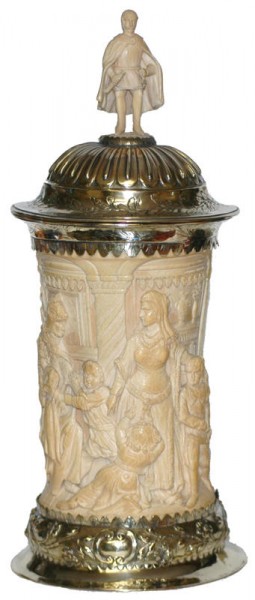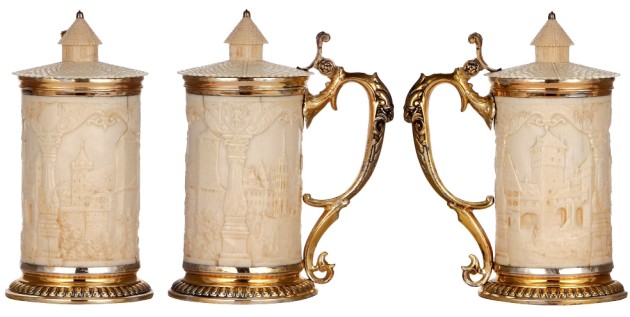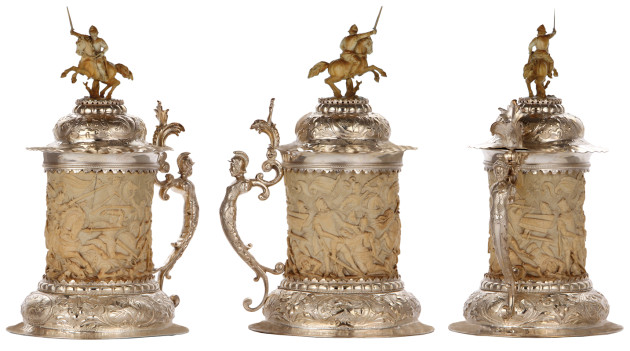
Ivory 13.5 in ht., late 1800s, very detailed battle scene, very shined up silver-plated mounts, ivory finial – soldier on horse . c.1850 [tsaco]
SO: What do the Dodo Birds and Ivory Steins Have in Common??
The first subject, the bird, is extinct! The first recorded mention of the Dodo was by Dutch sailors in 1598. In the following years, the bird was hunted by sailors, and also by their domesticated animals, and invasive species introduced during that time. The last widely accepted sighting of a Dodo was in 1662. Its extinction was not immediately noticed,; and the second (these ivory steins) will be extinct except on the black market if these proposed (US)Fish and Wildlife Propose regulations go through without a fight from those concerned, ▼ ▼ ▼ .
and a major change in their direction is made !!
I personally would like to thank Mr. Doug Bandow for his work on thiss important isssue.
The Obama administration is good at exuding moral righteousness and pandering to the cultural elite. It does both with its plan to effectively ban the sale of all ivory in America, including that purchased or inherited legally years, decades, or even centuries ago. If you can’t prove its age, toss it in the trash or be arrested and have your property confiscated — unless you have a political exemption.
Elephants are being killed for their ivory. It’s a tragedy, but one that has been going on for years. Conservationists are understandably frustrated, but most prefer not to reflect on the failure of their own prohibitionist policies. African governments are incapable of protecting the animals from highly armed poachers, who are responding to the high demand for ivory driven by Asians and especially Chinese. Unable to deal with those responsible for the elephant carnage, environmental extremists have found a more convenient target to attack: Americans who followed the law buying and selling old ivory objects which entered the U.S. lawfully long ago.
Ivory is a beautiful material used by craftsmen around the world to create a plethora of decorative and practical objects — canes, jewelry, beer steins, musical instruments, chess sets, netsukes, religious materials, games, sculptures, and much more. Often ivory supplemented or highlighted other items — keys for pianos, stocks for guns, accents for furniture. At the time people saw nothing wrong with the practice, and the elephants whose tusks provided the necessary raw ivory died long ago.
But advocates of banning the sale of antiques, and even destroying old objets d’art, seem more interested in punishing people who bought and sold ivory legally because they bought and sold ivory, not because doing so would prevent poaching. It is an exercise in moral vanity and political posturing, not practical conservation.
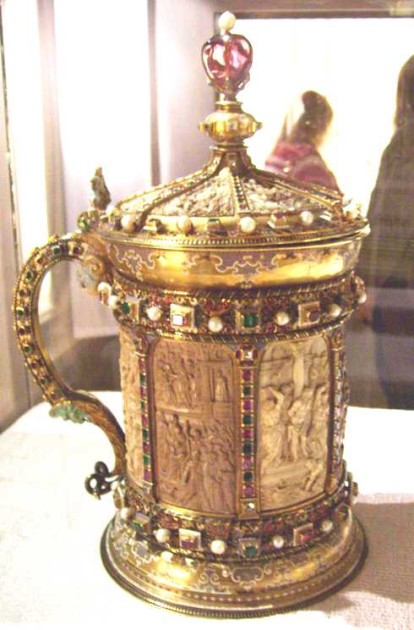
Above : ▲ Definitely an old objets d’art!! Can one image not being able to get one’s money invested in such back out should one need to sell it , say for needee money to pay for bad health results ?
Some ban proponents complain of the difficulty of distinguishing between new and old ivory. Actually, European carving disappeared decades ago: even an untrained government bureaucrat could distinguish between the ivory that filled 19th century Europe and tourist trinkets turned out today. Asian carving continues, but old and new differs in character, subject, wear, age, coloring, quality, and more. Nor do collectors of and dealers in antiques typically seek out poached ivory.
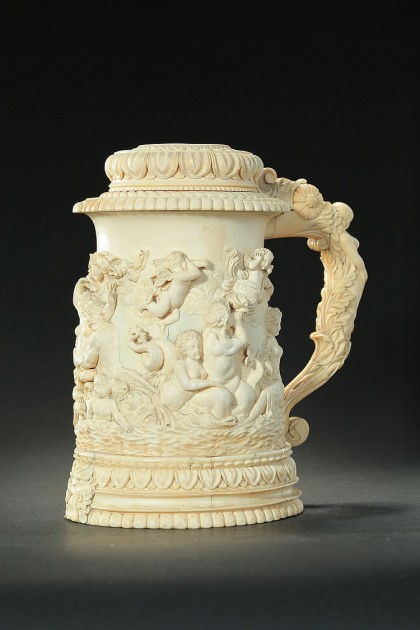
Expanded prohibition might make a few activists feel good, but punishing people who followed the law and invested in perfectly legal objects won’t save a single elephant today.
The traditional rules were easy to follow. Ivory imported prior to the completion of an international convention, known as CITES, in 1989 could be sold legally. Antiques with proper certification could be imported. You could be prosecuted for violating the law, but the government had to prove its case — as it normally does when charging people with a crime or other offense.
In mid-February the administration announced that it planned on changing the standards. If you were an average person who followed the law, played by the rules, invested your money in perfectly legal objects available without restriction and requiring no documentation, too bad. Now your collection or inventory is going to be essentially valueless.
Unless you are a member of the cultural elite, such as a museum or other non-profit. Or have enough money to try to comply with the expensive new rules.
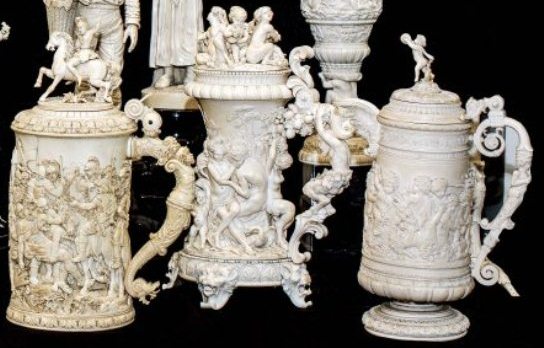
The above photo shows the different colorations of ivories that can occur due to usage storage, and exposure to outside influences, not including really dry surroundings which is why so many ivories are found heavily cracked. The one in the lower row center, while old, might be confiscated by the feds based on a decision by someone who wasn’t trained to determine its real age.
The new guidance from the U.S. Fish and Wildlife Service indicates that most every auctioneer, collector, and dealer — and anyone else who has purchased or received something made of ivory — better chat with a lawyer before attempting to sell their ivory possessions. The Feds will be free to scour every antique show, auction, collectibles store, estate sale, flea market, and junk shop confiscating anything that the owner cannot prove to be old. Even if Washington does little to implement its policy, the impact on value will be substantial. Who wants to put something up for sale that could be seized by Uncle Sam if he noticed? Who wants to buy something that might be impossible to sell in the future if the Fish and Wildlife bureaucracy gets serious? You’ll get a pittance for something that cost you thousands or tens of thousands of dollars.
Particularly striking is how the prospective rules are biased against average folks — with a middling collection or inventory of modestly priced items. It’s as if the policy was drafted to have maximum impact on people who don’t spend their time attending cocktail parties with the president.
 Point one, no imports even of antiques will be allowed:
Point one, no imports even of antiques will be allowed:
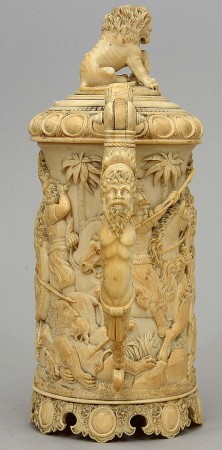
A 1.5 liter (appox.) all ivory carved German stein. Great workmanship. This one only had a $12 to 18 K estimate in an auction house in Florida.2012. If it sold for only that, then someone got a good buy!
Presumably no one really believes that today’s highly restricted antiques trade encourages poaching. Shipments must be accompanied by a CITES certificate and are inspected entering the country, which I know from experience. U.S. collectors will be cut off from the rest of the world simply as punishment for being collectors.
However, the rules apparently will exempt “museum and educational specimens.” Only “commercial” sales are restricted. Of course, this exception is about influence, not conservation. Under the administration’s reasoning, non-profit institutions will have a unique right to continue plundering ivory around the world and driving elephants to extinction. Perhaps I can start the Bandow Ivory Collectibles Museum, allowing me to join the president’s other important friends in their exempt status.
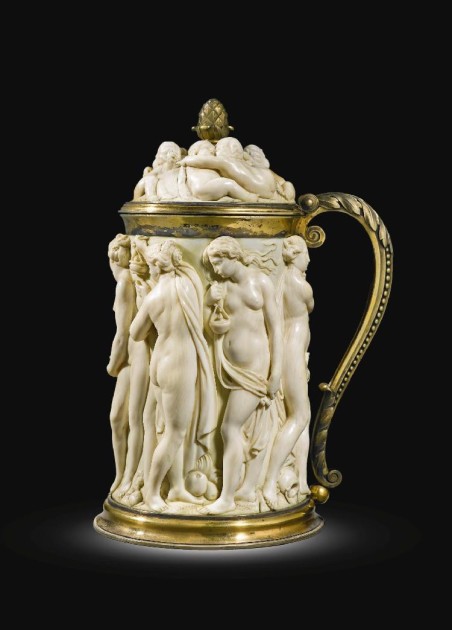
Above scene : The wise and foolish maidens SOTHEBYS-UK-2013
Point two, exports are banned, except antiques, which must be over 100 years old,
in what the government calls “exceptional circumstances, as permitted under” the Endangered Species Act. It is unclear whether the administration simply intends to increase the administrative hassle and cost of certifying shipments, or limit what can be exported. In either case, “certain noncommercial items” will be allowed, so nonprofits and others with friends in government likely will be able to hurdle any new burdens in a single bound. Collectors of sufficient means can try hiring attorneys or lobbyists. The rest of us will just get to pound sand.
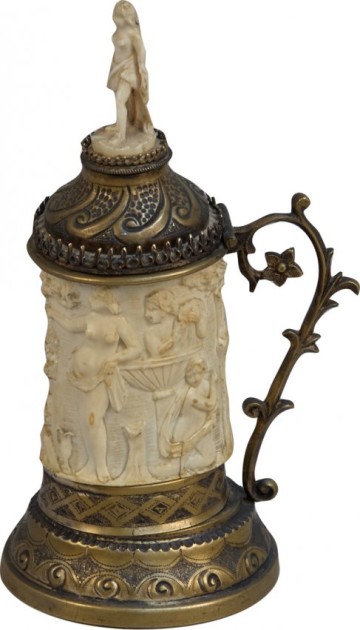
Ornate erotic scene . Small stein, (6 Inch) with hand worked bronze mounts.
Point three, only antiques, proved through “documented evidence,” will be eligible for sale across state lines.
How many antiques in America have “documented evidence” attesting to their age? For some odd reason 19th century ivory carvers were not in the habit of providing notarized statements of provenance along with the objects they were making. Which means that most antiques will be impossible to transfer across state lines. Indeed, you might not be able to sell after moving, since doing so could be treated as legally equivalent to selling across state lines.
Presumably museum transfers won’t be considered commercial even if the institution is out to make as much money as possible to fund its operations and future acquisitions. Indeed, the new policy will encourage non-profits to engage in low-key extortion with the message: “So sorry you can’t sell it since it lacks the proper documentation. But donate it to us and we can ensure a generous appraisal to get you a substantial tax deduction.”
More serious collectors and dealers with more valuable items will at least have the option of going to the trouble and expense of finding an expert and procuring a CITES certificate, when appropriate. Everyone else will be bureaucratic road kill. If you have lots of cheaper items, you’d spend most of their value trying to provide “documented evidence” to the government. Too bad you didn’t invest that money in campaign contributions to win better treatment!
Shown above: A nicely aged, smaller, ivory stein with heavily polished brass mounts, and most finger oil still intact.
Point four, only documented old ivory, imported before 1990, can be sold even within a state. Imagine you bought a bunch of ivory items as you moved across America during your career, and decided to settle in, say, Bozeman, Montana. Want to sell your old ivory? Too bad you’re not a museum or educational institution. Go to the thriving antique metropolis of Helena and see what you can get for your collection.
More likely, of course, you won’t have any evidence as to when the items were made or brought to America. Would every dealer in America attest that they were made decades ago? Who cares? That’s not real proof. And if you can’t prove an object’s age, tough. You can’t even take it — legally, at least — to the local flea market. Not that anyone would pay you much for something that is barely legal and could be banned at any time.
So Americans shouldn’t be fooled by administration rhetoric about still allowing legal sales. That’s only if you can provide the sort of proof that no normal person would have. Or are friends with the Interior Secretary, or a congressman feared by the Interior Secretary. Even if the Feds don’t send swarms of inspectors across America confiscating anything and everything ivory they find at the local church garage sale, the government will have crashed the price, preventing anyone from receiving anything close to what the items once were worth.
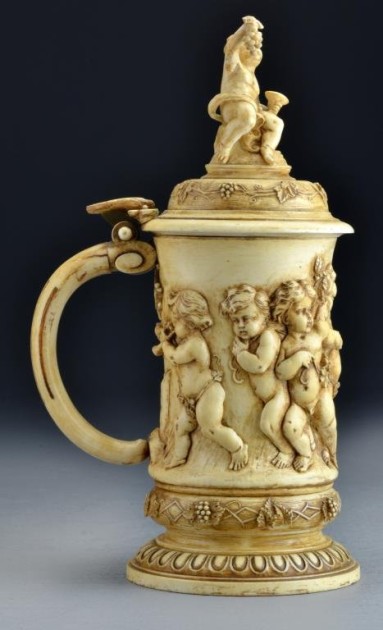
Value in 2010: $4,000 ~~~~ Value at end of 2014: $400.00 (??) or maybe a nice give away to your grandkids , so that maybe by the time they grow up , these stupid procedures will be reversed.
It will be expensive, but the better connected will at least have a chance of avoiding the rules. If you want to sell items that are old but not antiques in other states, you’ll need to find a broker, well-connected but discreet antique dealer, or private collector network. If you want to sell items internationally without new U.S. restrictions, you’ll need to procure a CITES certificate — it shouldn’t be too hard to find someone to concoct the right documentation at a price — and carry or ship the item abroad, selling it there.
However, if you have some nice pieces that you picked up over the years or inherited from your parents, worth a few hundred or thousand dollars and would like to get some money out of them for your retirement, you’re out of luck. If you were a middle-income collector or mid-level dealer who followed the law in amassing a modest amount of ivory goods that were evidently old but undocumented, too bad. After all, you never knew it, but you are the reason tens of thousands of elephants are being killed every year!
Ironically, the new policy will reduce genuine conservation efforts directed at elephants. Today the U.S. Fish and Wildlife Service investigates poachers and their allies. The administration could attempt to better support African countries seeking to protect elephants, find and interdict illegal ivory shipments, and prosecute those who sell new ivory. Instead, Fish and Wildlife will shift away from those linked to the killing of elephants and target thousands or tens of thousands of Americans who were so stupid as to follow the rules in purchasing legal ivory.
At a stroke the administration will have multiplied the amount of ivory considered contraband: every object with even trace amounts of ivory for which no documentation is available will be illegal to sell in any form at any point. Every piece of old ivory which cannot be proven to be a century old will be illegal to sell across state lines.
The number of people breaking the law facing arrest also will explode, as anyone trafficking in old, formerly legal ivory will be as much a criminal as operators handling large, ongoing flows of new, poached materials. Collectors with large collections and dealer with large inventories, all lawfully acquired, will stand in the same legal position as those who knowingly import and sell poached ivory from elephants killed last week. The Feds won’t just have to monitor every antique shop and show in America. There is likely to be an explosion of “bone” and “faux ivory” sales on eBay, with most photos and conversations held offline.
Uncle Sam will need informants and wiretaps to catch these ivory criminals.
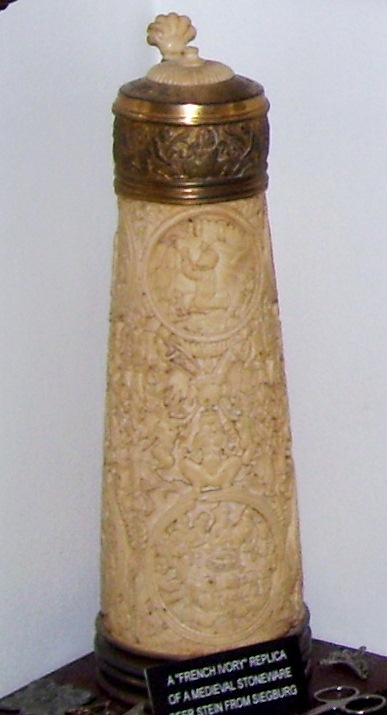
French Ivory (plastic – Celluloid) [FWTD]
A term used to describes items made using the earliest plastic , which has the color of ivory. I have only seen this one stein made of it and none of the several other Master Steinologists who looked at it could not figure out what the material was. It is a copy of the steins supposedly owned by Martin Luther. Now this stein is rare.
Uncle Sam will need informants and wiretaps to catch these ivory criminals.
Given what Mr Bandow just said, that is now the biggest fear I have. and I am not an ivory stein collector! Never had one, never wanted one = too rich for my blood!!)
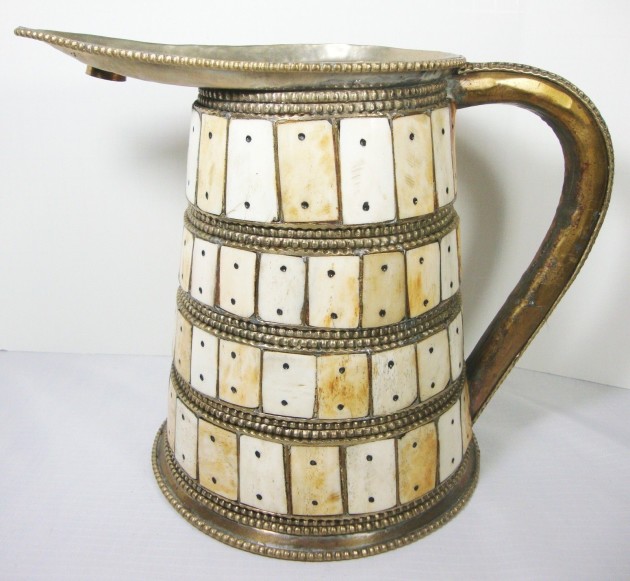
Suppose some new collector come over to visit the SM&T and sees this piece above ▲ and thinks it is made of Ivory. Being a “do-gooder,” he then reports it to the Feds, and WOW next a team of government agents with a search warrant descend on my home and tear it apart looking for ivory. If not trained they might even elect to confiscate this great looking and unique [!] bone stein!!
What it ▲really is: A Small, very hand worked brass and bone server – Small cut and sized bone tablets are attached to a brass body by what looks to be small brass pins. It makes an interesting display. I have also seen this type of “brass pined” work done on with small cut pieces of mother of pearl. Above stein’s age and origin is unknown at this time [Early 2014.] By design alone I am inclined to think (SWAG) that this possibly comes from the Kashmir – Tibetian area. 5.5 inches tall .
“Does the below stein appear to be new New Carved Ivory to you Mr. Rookie Federal Fish & Wildlife Investigator?”
“Yes ” “you say? ”
“We’ll it isn’t! It is made of Meerschaum and made in England well over 100 years ago; BUT if you think it is and then you take it out of my house .who do I complain too-?- hopefully before your agency destroys it ?”
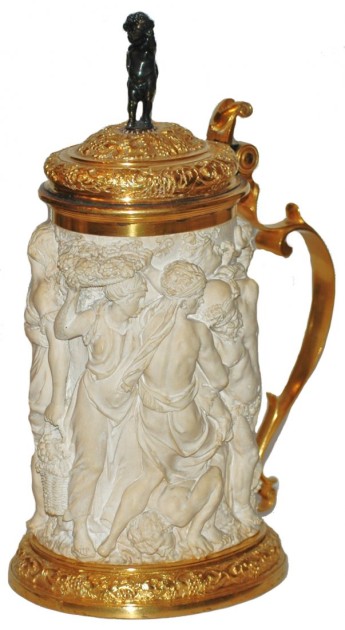
1-4L. Bacchus orgy. Brass mounts. Meerschaum .Uncommon. Ron Fox Auctions
Moreover, anyone whose investment in old ivory faces a wipeout in value by Washington’s action will have no incentive to aid the government in its campaign against new ivory. The administration inadvertently will have turned collectors and dealers into potential accomplices of poachers, since those with old ivory to sell will be tempted to work with dealers who have experience operating illegally, that is, who today handle illicit ivory work.
While proponents of the administration’s new policy are busily engaged in moral preening, more elephants will die. After which activists will look for new scapegoats. And more elephants will die.
Of course, if government can steal so much from so many, the rights to property and due process are not secure. Spend and invest in reliance on the law, and then face thousands or even millions of dollars in losses from one arbitrary rules change. But never mind so long as friends of the administration with special status find a way around the policy.
The administration should target poachers who kill elephants, not collectors and dealers who followed the law. If Fish and Wildlife does turn average Americans into criminals, Congress should refuse to fund implementation and enforcement of the rules. If necessary, members should withhold funding for agents spending their time harassing everyone except those who traffic in illicit ivory.
The campaign to save elephants should not become just another excuse to expand government power and curtail individual liberty. Doing so isn’t fair to the American people — or helpful to African elephants.
Douglas Bandow.
About the Author:
Doug Bandow is a senior fellow at the Cato Institute, specializing in foreign policy and civil liberties. He worked as special assistant to President Reagan and editor of the political magazine Inquiry. He writes regularly for leading publications such as Fortune magazine, National Interest, Wall Street Journal, and Washington Times. Bandow speaks frequently at academic conferences, on college campuses, and to business groups. Bandow has been a regular commentator on ABC, CBS, NBC, CNN, Fox News Channel, and MSNBC. He holds a J.D. from Stanford University.
.5 liter [?] A Nurnberg made ivory with gilded mounts with carved building scenes and in an “old town” tower form. [tsaco]
Please send a copy of this page to anyone you know that collectss anything that might contain Ivory ., especially antique beer steins!
Please !!
The editor 2.26.2014
.
3 -35 -2014 AN UPDATE EMAIL FROM ONE OF THE ATTORNEYS REPRESENTING THE IVORY COLLECTORS THAT ATTENDED THE IVORY STUDY COMMITTEE METTING IN ARLIGTON VA.
Friends,
I’m writing to you from a hotel room in Washington DC, already late for my drive back home. Before I hit the road, I want to share with you what happened yesterday at the subject meeting. I’ll provide more details when I get back, but here are the high points:
The Bad News
- Special interest groups are already lobbying Congress to rush changes to the law that will create SEVERE penalties for anyone involved with wildlife trafficking, which will include Domestic Ivory Trade under current proposals. They want to make trading ivory punishable under RICO, Federal Money Laundering statutes, and the Travel Act. These statutes would make violations of the law easier for federal authorities to prove, and the Advisory Council is arguing for increasing penalties to felonies with 5 year prison sentences. They are also pursuing new restitution laws that will allow the government to “disgorge profits from ivory traders” and “return the money to the state or country of origin.” Where no state or country can be identified, they want to create a new slush fund to use to enhance enforcement and conservation efforts.
- They are working hard to build Congressional support to push these changes through. Sen Diane Feinstein is leading the charge in the Senate. They are looking for a member of the House to lead the effort. When talking to Congressional members, they are focusing on capturing Chinese kingpins in the poached ivory trade, so members of Congress have no idea that these laws could be used against US citizens who currently and have always abided by the law working with pre-ban ivory.
- Although they say their focus is on “5 or 7 Kingpins in China”, they repeatedly said the United States needs to lead the way with enforcement of a Domestic Ivory Ban to be a model for the rest of the world to emulate. They know the real problems with illicit trade in poached ivory are in Asia, but they are frustrated by their inability to do much about it in foreign countries. They expressed dismay over what they characterized in the United States as the lowest number of prosecutions in wildlife trafficking in the world, and concern that typical US prison sentences were only 2 months of incarceration. The enforcement advocates clearly want more money and manpower to prosecute many more people in the US to drive up their statistics to “impress other countries.” Since there is no poaching taking place in the US and USFWS has been effective at keeping poached ivory out of our country, who do you think they will go after?
- The Advisory Council is advocating for measures to reduce demand for ivory worldwide and “change people’s behavior” through advertising campaigns and enlisting Hollywood celebrities. They compared what is currently legal ivory trade to smoking and illegal drug trades (repeatedly).
- The Advisory Council is also advocating for public/private partnerships with corporations and non-governmental organizations to help inform them what can be done to fight wildlife trafficking, which would include domestic ivory trade if they get their way. They talked about eBay, Coke, Pepsi and other companies that they’d like to see help them. AT NO TIME DID THEY TALK ABOUT PARTNERING WITH ANYONE WHO DEALS WITH LEGAL IVORY IN THE US, AND IT IS CLEAR THEY HAVE MADE NO EFFORT TO REACH OUT TO LEGAL USERS OF IVORY TO SOLICIT THEIR INPUT.
The Good News
- The Advisory Council was largely ignorant about the legal use of domestic ivory, and they expressed surprise and concern about the number of people who wrote in expressing concern leading up to this meeting. Clearly, they see serious potential political problems if the legal ivory trade organizes to oppose this ban. I challenged them directly on their failure to include people who deal with legal ivory in their deliberations and proposals
- One of the key members of the Council advocating for changes in the law admitted to me that the Ivory Ban “came down from above” and the he had not even read the domestic ivory ban proposals until shortly before this meeting. He said to me after the meeting concluded that the proposed ban was extremely broad and he understands why people working with Ivory today are in a panic.
- There were about 25 people who came out to comment about the Ivory Ban, and about half spoke eloquently about reasons to oppose or soften the ban. Representatives of musical instrument dealers, orchestras, auctioneers, antique collectors, knife dealers and scrimshaw artists stood up and told the Council the Draconian impact that the ban would have on their lives without saving a single African elephant. The Council was clearly attentive and concerned about their comments. There were also animal rights activists who made comments, some of which were quite extreme (i.e. elephants are “more evolved than humans” and “all ivory comes from poached elephants”). The Activist’s comments spoke for themselves and added nothing new to the discussion.
- Sandra Brady’s comments stood out from the others. Sandra captured how the current legal system has failed to prevent poaching and the futility of a domestic ban on that objective. She also did a great job personalizing the devastating impact on small businesses and the lives of artists, artisans and collectors who have always complied with the law and who share the goal of ending the slaughter of poached elephants.
Bottom Line – we haven’t stopped the Domestic Ivory Ban freight train, but we may have slowed it down. By the end of the meeting, Advisory Council members acknowledged that the Domestic Ivory Ban posed genuine problems and political challenges. They noted that everyone agreed on measures they want to take to stop illegal poaching (prosecuting poachers and traffickers of poached ivory), and but for the Domestic Ivory Ban their proposals would not be controversial.
The timing of new rules is not yet clear. There will be something published in the next few weeks addressing CITES that possibly could include revocation of an existing special rule under the Environmental Species Act. This could set up a legal framework prohibiting interstate trade of ivory. They said to expect a 30 day comment period on that rule.
The “final rule” should come out in June, after which there will be a comment period. We specifically asked that these rules not be issued as “interim final rules” which would go into effect immediately, and instead asked that any rules published be subject to comment before they can be enforced. I think we have a good chance of getting this because of the wide ranging concerns raised, but nothing is guaranteed.
What you need to do
- Call your Congressman and Senators TODAY! Activist groups are already lobbying Congressmen heavily, and they are totally misrepresenting what the regulations and legal changes will do to you. You need to inform them about what the proposed changes in the law will do to you, your collections, your businesses, and your families. The message is simple – We all want to stop elephant poaching, but these laws punish innocent Americans, not elephant poachers or illegal traders in Asia.
- Call your trade organizations and make sure they are representing you. Groups like the NRA, AARP, collectors associations, professional associations, knife clubs, gun clubs, industry lobbying groups – all of them need to hear from you and be educated about the severity of this threat. These calls have a multiplier effect when they lead back to law makers, and they are starting to get people’s attention!
- Spread the word on social media. Use Facebook, Twitter, e-mail lists, internet forums, and all the ways you communicate people to spread the word about what the government is doing and why the Domestic Ivory Ban is a very bad idea.
Senior Fellow, Cato Institute www.cato.org
[END – SOK – RD – 21 -5R]

I like fuzzy drinks. When i was real young that meant soda-pop. Then when I got older it was beer. Now it is Alla-Seltzer !

